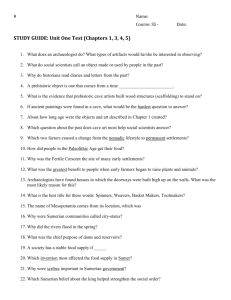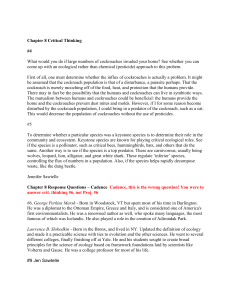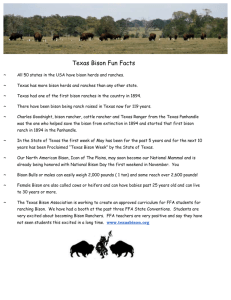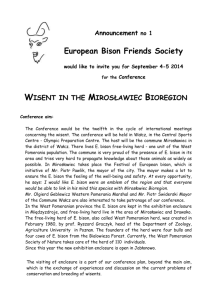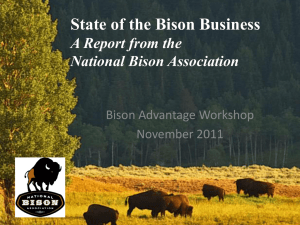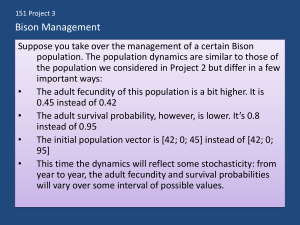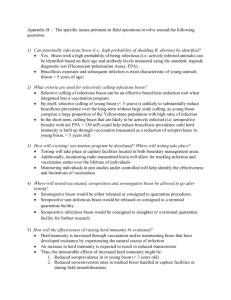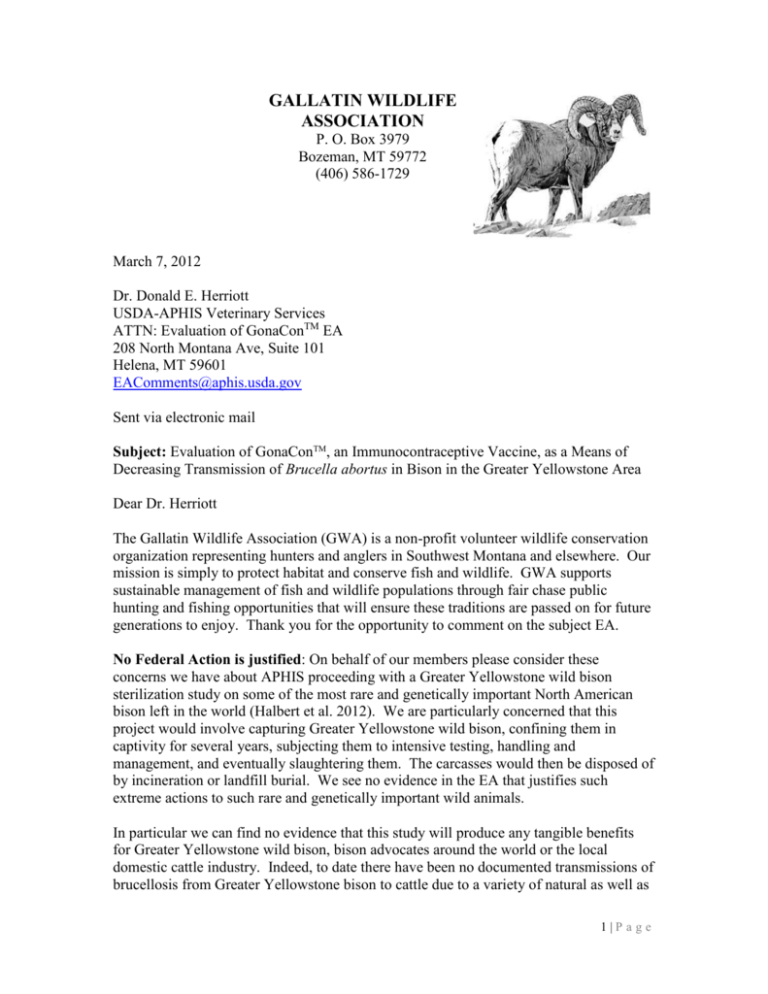
GALLATIN WILDLIFE
ASSOCIATION
P. O. Box 3979
Bozeman, MT 59772
(406) 586-1729
March 7, 2012
Dr. Donald E. Herriott
USDA-APHIS Veterinary Services
ATTN: Evaluation of GonaConTM EA
208 North Montana Ave, Suite 101
Helena, MT 59601
EAComments@aphis.usda.gov
Sent via electronic mail
Subject: Evaluation of GonaConTM, an Immunocontraceptive Vaccine, as a Means of
Decreasing Transmission of Brucella abortus in Bison in the Greater Yellowstone Area
Dear Dr. Herriott
The Gallatin Wildlife Association (GWA) is a non-profit volunteer wildlife conservation
organization representing hunters and anglers in Southwest Montana and elsewhere. Our
mission is simply to protect habitat and conserve fish and wildlife. GWA supports
sustainable management of fish and wildlife populations through fair chase public
hunting and fishing opportunities that will ensure these traditions are passed on for future
generations to enjoy. Thank you for the opportunity to comment on the subject EA.
No Federal Action is justified: On behalf of our members please consider these
concerns we have about APHIS proceeding with a Greater Yellowstone wild bison
sterilization study on some of the most rare and genetically important North American
bison left in the world (Halbert et al. 2012). We are particularly concerned that this
project would involve capturing Greater Yellowstone wild bison, confining them in
captivity for several years, subjecting them to intensive testing, handling and
management, and eventually slaughtering them. The carcasses would then be disposed of
by incineration or landfill burial. We see no evidence in the EA that justifies such
extreme actions to such rare and genetically important wild animals.
In particular we can find no evidence that this study will produce any tangible benefits
for Greater Yellowstone wild bison, bison advocates around the world or the local
domestic cattle industry. Indeed, to date there have been no documented transmissions of
brucellosis from Greater Yellowstone bison to cattle due to a variety of natural as well as
1|P age
management induced factors (White et al. 2011). Transmission risk from Greater
Yellowstone bison to cattle is already low by June 1 and extremely low by June 15 (Aune
et al. 2007; Kilpatrick et al. 2009; USDI Yellowstone National Park. 2009; Jones et al.
2010) even though sero-prevalence in adult female bison has increased or remained
constant at about 60% (Hobbs et al. 2009) . On the other hand, additional habitat outside
the Park is being recognized as a critical factor in preserving and enhancing the Greater
Yellowstone bison population(s) (Geremia et al. 2011).
As well, two genetically distinct and clearly defined subpopulations were recently
identified based on both genotypic diversity and allelic distributions (Halbert et al. 2012).
The importance of preserving these subpopulations cannot be overstated. Therefore, we
urge APHIS not to sterilize any of these bison and to select the “no action” alternative as
laid out in the EA. Please divert the time, personnel, energy and funding necessary to
complete this project to better address the site specific habitat conflicts that may occur
between free-ranging bison and private land livestock within the Greater Yellowstone
Ecosystem. Securing additional habitat for these bison within the GYE is critical.
Forgo Intrusive Government Intervention and Protect Habitat: Furthermore, this
APHIS proposal is at odds with one of the primary goals of the Interagency Bison
Management Plan, which APHIS is a signatory partner, specifically, the goal of
“maintain[ing] a wild, free-ranging bison population” in the GYE. Capturing, confining
and sterilizing bison works against that goal. As well, the processes for long-term
conservation of free-ranging ungulates such as bison operate on a large landscape scale
over long periods of time (White et al. 2011). Thus, access to habitat over a larger
landscape is critical for Greater Yellowstone bison conservation, while the risk of
transmission to cattle is already very low and is indeed manageable. We are concerned
that instead of working to further manage the cattle/bison interface in a manner that
works for everyone, APHIS proposes to unilaterally capture, confine, sterilize,
intensively test, feed and handle wild bison, essentially treating them like domestic
livestock rather than a free-ranging wildlife population as directed by the IBMP’s
mission.
Of further concern and as noted in the EA, bison injected with GonaConTM would be
unfit for human consumption. Thus, APHIS proposes to end the study with the wasteful
slaughter and disposal or incineration of these genetically important bison. This intensive
and intrusive project is in direct conflict with Montana Fish, Wildlife & Park’s goal of
restoring and conserving these bison as valued native wildlife in Montana, again working
counter to the IBMP goal of maintaining a wild, free-roaming bison population within the
GYE. We are also concerned about the loss of public viewing and hunting opportunities
these bison might otherwise provide in southwest Montana if they were allowed to
migrate, expand their range, reproduce and establish new home ranges over time.
Failure to Secure Consensus Agreement from the IBMP Partners: As well, how did
this project originate? We are concerned this was not a consensus driven agreement
between all the IBMP partners. Regarding bison management, we have been told the
IBMP partners work on a consensus driven basis. GWA members have faithfully
2|P age
attended all or nearly all IBMP meetings over the years, and we have no recollection that
this project was publicly reviewed and approved through the IBMP partner consensus and
public process. If it exists, please provide the documentation that this project resulted as
a consensus driven agreement of the IBMP partners. In particular, did the Montana FWP,
Gallatin National Forest and tribal representatives from the Nez Perce, Salish-Kootenai
and Inter-Tribal Bison Cooperative agree this bison sterilization EA/project was an
appropriate course of action? APHIS should immediately cease any further unilateral
work related to this EA without the consensus support of all the IBMP partners regarding
this bison sterilization proposal.
If the Study must Proceed – Use other Bison: While we see no compelling reason for
this study to proceed, if the IBMP agencies find some merit in its intentions, we suggest
APHIS or some other approved research facility acquire a domestic source of bison to be
sterilized with GonaConTM to test whether this procedure works. Let me be clear, we
oppose the wanton destruction of any of the rare and genetically important North
American wild bison that make up the Greater Yellowstone bison population(s).
Develop Bison Habitat Partnerships as an Alternative to Slaughter or Sterilization:
The critical importance of expanding the habitat available to the Greater Yellowstone
bison herds is becoming increasingly recognized by the IBMP partners and the general
public (U.S. Forest Service. 2006; USDI Yellowstone National Park 2008; USDI
Yellowstone National Park. 2008(A); Geremia et al. 2011; White et al. 2011; Halbert et
al. 2012). Furthermore, we do not buy the illegitimate argument that these study bison
would be sent to slaughter by the IBMP agencies anyway. Again, we see no evidence
that this APHIS sterilization proposal is a consensus driven decision of the IBMP
partners. Slaughter or sterilization is a disingenuous non-choice, which ignores and/or
diverts agency resources away from developing much needed habitat partnerships.
For example, there are significant areas of bison friendly private land as well as public
lands that are currently unoccupied by bison. One example is the Dome Mountain Area,
which includes the private 5,000 acre bison friendly Dome Mountain Ranch, the public
Dome Mountain Wildlife Management Area as well as the surrounding Gallatin National
Forest Lands. Other significant opportunities exist in the Madison Valley, which is
critical winter range for Greater Yellowstone elk. Bison habitat partnerships could be
developed with the Elk Meadows Ranch and the Sun Ranch down to the Wall Creek
WMA and the Indian Creek area. Translocation/restoration and conservation of bison to
historic habitat within the Upper Gallatin watershed, which includes areas within
Yellowstone National Park, the Gallatin National Forest and the Montana FWP Gallatin
Wildlife Management Area, is a very real alternative to bison slaughter or sterilization.
Brucellosis in Bison isn’t the Problem: This APHIS GonaConTM proposal focuses on
sterilizing wild bison and perpetuates the misleading hypothesis that brucellosis in bison
is the problem to be addressed. Such pontifications delay or deny the exploration and
nourishment by the IBMP partners of sustainable long term habitat/management
partnerships which benefit both wild bison (and elk) and local land/livestock owners. We
believe most wildlife biologists would not be worried about brucellosis in these bison if it
3|P age
weren’t a concern of the cattle industry. Furthermore, “healthy” wild bison are those that
have been exposed to the elements of their wild environment including diseases, of which
brucellosis is just one of many. Survival of the fittest, allowing for a build-up of natural
immunity to brucellosis and expression and retention of important genetic diversity
through natural selection is a much more sound approach for wild bison management in
this instance. Studying coevolution and natural immunity in wildlife, which may be
represented by both sero-positive and/or sero-negative animals, is by far a much better
research priority regarding promoting “healthy” bison or elk.
Furthermore, elk not bison are likely the primary threat of transmission of brucellosis to
susceptible cattle in the GYE (Beja-Pereira et al. 2009). So why is APHIS proposing to
sterilize bison? What does this study buy us in terms of bison health, productivity or
access to additional habitat? What does this buy us in terms of protection of susceptible
cattle when elk are the main vector? Some have stated a concern that bison may transmit
brucellosis to elk however that conjecture is not supported by the best available science.
Indeed, transmission between bison and elk appears rare (Proffitt et al. 2010) despite
close association between the two species in the winter and spring (Ferrari and Garrott
2002), which is the primary risk period for transmission.
This is not to suggest APHIS should undergo an elk sterilization project. To the contrary,
this speaks to the value of working on habitat partnerships and cattle management and
vaccination systems that protect the susceptible domestic animal from infection from elk,
bison and perhaps other wildlife that may have been exposed to this exotic livestock
disease over the years. Vaccinating my dog for rabies is a much better approach then
trying to vaccinate or sterilize all the skunks to protect my dog.
Developing habitat partnerships and livestock management scenarios that protect
susceptible cattle when and where they are at risk are areas where we can continue to
make real progress. Such cooperative activities provide opportunities to work together
on something that will likely yield significant benefits to individual cattle operations as
well as the livestock industry at large.
Please Provide the Public Comment Record: We question the utility of APHIS
spending public dollars on sterilizing some of the most genetically important and rare
wild bison on the planet. We suspect this approach will be challenged by the public and
will likely be challenged by some if not all of the other IBMP agency partners. In that
regard, we request copies of the public comment record on this proposal. In addition,
what if in the minds of APHIS officials this project works, then what? What will be the
larger application of this bison sterilization study? The EA should be clear about where
this is headed. Regardless, we contend this is a divisive, expensive and ill-advised
diversion of federal funding that will result in a “tail-chasing” effort with no end in sight.
Please Outline the Costs and Consider Other Alternatives: In addition, there is an
insufficient discussion about all the costs associated with this project. Therefore, the EA
must be supplemented to reveal the true costs of this project, both economically and
ecologically. While elk are the proving to be the main threat to cattle in terms of
4|P age
brucellosis transmission, the best way to address the threat of brucellosis transmission
from wildlife to domestic livestock is by working to secure a better livestock vaccine,
better vaccine protocols and better livestock management systems (grazing systems,
classes of livestock, fences, timing of use, etc.). APHIS can indeed help ensure
individual livestock producers are certified brucellosis-free (Wyoming Livestock Board
et al. Undated). Please consider this as an alternative way to proceed.
For instance, there is much that can be done to prevent or reduce the risk of brucellosis
transmission by merely managing livestock use around the primary window of risk (last
trimester of pregnancy through the calving period – February – June). This is especially
true on important wildlife winter ranges and calving habitats. Indeed, very little livestock
management has to change on the majority of the habitat currently available to bison, as
well as within the areas we have discussed here for bison habitat expansion. Most of
these areas are not even used by cattle, or if they are, not until after June 15th when the
primary period of risk is over (White et al. 2011).
Furthermore in research conducted by Yellowstone National Park (2009), peak calving
for Greater Yellowstone bison occurred during April 25 to May 26 (80% of births) and
calving was finished by June 5. Indeed, APHIS recognized low risk bison in an Oct. 17,
1997 memo placed in the original Bison Management Plan EIS (USDI National Park
Service et al. 2000) in Appendix G which stated:
Low risk bison are those bison that do not present a significant risk of transferring
brucellosis to livestock through environmental contamination – bulls, yearling,
calves and postpaturient female bison that have live calves and have totally passed
all birth membranes.
Thus, by June 5th in the GYE nearly all if not all bison pose no or only an extremely
small risk to cattle at all. On the other hand, elk use a much broader landscape and pose a
more pressing challenge to address because they typically calve a month later than bison.
However, the good news is elk and cattle have been sharing this larger landscape for
quite a while with little if any transmission of brucellosis. Thus, if APHIS and the other
IBMP partners are really interested in serving/protecting the livestock industry, please
divert the resources that would be required to complete this bison sterilization study to
activities that will better protect susceptible livestock (when and where they are at risk)
over the larger landscape currently used by elk.
The Effects on the Wild Nature of Greater Yellowstone bison have not been
Adequately Recognized, Analyzed and/or Avoided by the only Action Alternative
Considered: Administering GonaConTM to sterilize bison will interfere with and weaken
natural selection for all sorts of bison characteristics, including resistance to brucellosis.
Whereas the more-fit bison should exhibit better survival and reproduction, the treatment
proposed would affect more-fit and less-fit bison equally, eliminating the selective
advantage of any useful traits and weakening natural selection. Removal of some bison
from the pool of reproducing animals will reduce the genetically-effective population size
5|P age
of Yellowstone bison herds and enhance genetic drift that will compete with natural
selection that is necessary to maintain wild characteristics of the animals.
These effects are likely even more significant given the recent findings of Halbert et al.
(2012), which recognizes two distinct sub-populations of bison exist within Yellowstone
National Park. Regardless, the adverse and likely significant impacts of this bison
sterilization project were not adequately analyzed and displayed in the EA. Furthermore,
these impacts can be avoided by proceeding with alternatives to this heavy handed wild
bison manipulation/sterilization approach. Instead, we suggest encouraging proper cattle
vaccination and management of the cattle/wildlife interface, in particular at cattle feed
lots, to prevent intermingling during the primary risk period of brucellosis transmission
(February to June).
Show Us Your Plan: Another significant downside of this study is that it continues to
promote the unsubstantiated false hope to the cattle industry that reducing seroprevalence in wild bison (the detection of anti-bodies to Brucella abortus) is an effective
strategy that will actually yield some benefits. APHIS continues to argue and mislead the
public in a piecemeal fashion that Brucella abortus can somehow eventually be
eliminated from all free-ranging wildlife in the GYE. APHIS would have us believe this
wild bison sterilization project is but one step in that overall direction (Page 9, EA).
Since APHIS truly believes such an eradication strategy is feasible, they owe an honest
explanation to the interested publics and the other IBMP partners how such a program
would occur across the 3-State GYE in a reasonable and cost effective manner. Is APHIS
willing to produce such a comprehensive plan of action? Is brucellosis eradication from
all the wildlife in the GYE still an APHIS goal?
Furthermore, does APHIS know whether or not bull bison or bull elk can transmit
brucellosis to the female of their species during breeding? We have seen no evidence
that suggests this cannot happen and indeed we understand that bull bison have
transmitted Brucella abortus in their semen during breeding, although perhaps at low
levels (unpublished studies conducted by APHIS, personal communication Becky Fry).
As we understand it, male transmission of Brucella sp. to females is a potential concern
in domestic canines, swine and feral swine. Is that an accurate understanding? How
would transmission of Brucella abortus by male bison to female bison or male elk to
female elk affect this study? Please display in the EA the current science related to male
to female transmission potential.
It is our contention that brucellosis eradication in all the wildlife within the GYE is not
reasonably possible. Furthermore, focusing on reducing sero-prevalence in bison is an
endless, self-serving, delusional and never ending “tail chasing” pursuit. What does that
accomplish? However, should APHIS disagree, we would like to see your plan of action
that leads to more protection for specific cattle operations as well as more tolerance for
wild bison in southwest Montana. To date however, we have seen no convincing
evidence from APHIS or anyone else that intensively manipulating and slaughtering wild
bison to reduce sero-prevalence and/or attempting to eradicate brucellosis in the GYE is
6|P age
an effective strategy to protect cattle or to see bison managed respectfully as free-ranging
wildlife in the GYE.
Brucella abortus is a naturalized species in the GYE. It has been present in wildlife for
many decades, nearly a century. It exists in bison, elk and probably many other species.
There is no evidence that it can be eliminated. Attempts to eliminate Brucella from this
ecosystem are causing more perturbations and deviations from the Park Service goal of
naturalness and “unimpairment” than would occur if the wildlife of the Park were
allowed to coevolve naturally. As well, the types of intrusive management actions
proposed by APHIS in the EA prevent the natural migration of bison to critical habitat in
Montana, thereby disrupting the goal of maintaining a free-ranging bison population(s) in
the GYE.
Loss of Public Hunting Opportunities and Human Health Concerns: GWA members
are also concerned about the human health risks associated with using GonaConTM or
other vaccines in free-ranging Greater Yellowstone wildlife. What will be the impacts to
public hunting opportunities from sterilization of native wildlife? From the reference on
page 7 to the EPA restriction: "Per the conditions of the approval from EPA to use
GonaCon™ in bison in this confined experimental use study, animals treated with
GonaCon™ cannot be consumed by humans. These animals would be disposed of by
incineration or landfill burial." Even if this sterilization proposal proves effective in the
eyes of APHIS, won’t its eventual use in other free-ranging wildlife significantly disrupt
public hunting opportunities? What are the potential human health risks? We are
concerned about the potential impact to public hunting opportunities to harvest an
organically grown free-ranging wild bison in the future. The adverse effects and
consequences of pursuing this type of injection sterilization and/or vaccination of native
wildlife that are hunted should be revealed in the EA.
Respect and Conserve Wild Bison as Valued Native Wildlife: In summary, for the
reasons outlined above and on behalf of GWA members I urge APHIS to select
Alternative A, the No Action alternative. Please forgo this ill-advised bison sterilization
project and save tax payer dollars. Please also seek other alternatives to protect the local
cattle industry from brucellosis transmission, which is more likely to come from elk.
Most importantly, we desire to see the IBMP partners, including APHIS, respect and
conserve Greater Yellowstone wild bison as valued native wildlife throughout the GYE
while reasonably addressing the potential conflicts with susceptible cattle when and
where they may occur. This is an alternative that we can all work on together.
Sincerely,
Glenn Hockett
Volunteer President, Gallatin Wildlife Association
P.O. Box 3979
Bozeman, MT 59772
(406) 586-1729
www.gallatinwildlifeassociation.org
7|P age
Working to Protect Habitat and Conservation Fish & Wildlife
Literature Cited
Aune, K, J. Rhyan, B. Corso, T. Roffe. Undated. Environmental persistence of brucella
organisms in natural environments of the Greater Yellowstone Area – a preliminary
analysis. 8 p.
Beja-Pereira, A., B. Bricker, S. Chen, C. Almendra, P.J. White, and G. Luikart. 2009.
DNA Genotyping Suggests that Recent Brucellosis Outbreaks in the Greater Yellowstone
Area Originated from Elk. Journal of Wildlife Diseases, 45(4): 1174-1177.
Ferrari, M.J. and R.A. Garrott. 2002. Bison and elk brucellosis seroprevalence on a
shared winter range. J. Wildl. Mange. 66:1246-1254.
Geremia, C., P. J. White, R. L. Wallen, F. G. R. Watson, J. J. Treanor, J. Borkowski, C.
S. Potter, R. L. Crabtree. 2011. Predicting Bison Migration out of Yellowstone National
Park Using Bayesian Models. Plos One 6(2): e16848. Doi:10.1371/journal.pone.0016848.
www.plosone.org.
Halbert, N.D., P. J. Gogan, P.W. Hedrick, J.M. Wahl, and J.N. DERR. 2012. Genetic
Population Substructure in Bison at Yellowstone National Park. Journal of Heredity
Advance Access published February 8, 2012. The American Genetic Association. 2012.
All rights reserved. For permissions, please email: journals.permissions@oup.com.
Hobbs, N.T., R.L. Wallen, J.J. Treanor, C. Geremia, and P.J. White. 2009. A stochastic
population model of the Yellowstone Bison Population. Colorado State University, Fort
Collins, Colorado.
Jones, J.D., J. J. Treanor, R. L. Wallen, and P. J. White. 2010. Timing of parturition
events in Yellowstone bison Bison bison: implications for bison conservation and
brucellosis transmission risk to cattle Wildlife Biology 16(3):333-339.
Kilpatrick, A.M., C.M. Gillin and P. Caszak. 2009. Wildlife–livestock conflict: the risk
of pathogen transmission from bison to cattle outside Yellowstone National Park. Journal
of Applied Ecology. pp 1-10.
Proffitt, K.M., P.J. White, R.A. Garrott. 2010. Spatio-temporal overlap between
Yellowstone bison and elk – implications for wolf restoration and other factors for
brucellosis transmission risk. Journal of Applied Ecology 47: 281-289.
U.S. Forest Service. 2006. Gallatin National Forest Plan amendment northern
Yellowstone winter range acquisition OTO tract, Decision Notice and FONSI. Gallatin
National Forest, Gardiner Ranger District, Gardiner, MT pp. 24 with appendixes.
8|P age
USDI, National Park Service and USDA, Forest Service, Animal and Plant Health
Inspection Service, 2000. Final Environmental Impact Statement for the Interagency
Bison Management Plan for the State of Montana and Yellowstone National Park,
Washington, DC.
USDI Yellowstone National Park. 2008. Conservation Genetics of Yellowstone Bison.
Interagency Bison Management Plan Briefing Statement. 2 pp.
USDI Yellowstone National Park. 2008(A). Potential bison winter range; Upper Gallatin
River Basin. Yellowstone Spatial Analysis Center 307-344-2246.
USDI Yellowstone National Park. 2009. Implications of Bison Birth Synchrony and
Brucella Persistence on Adaptive Management. Interagency Bison Management Plan
Briefing Statement. 1 pp.
White, P.J., R. L. Wallen, C. Geremia, J. J. Treanor, D. W. Blanton. 2011. Management
of Yellowstone bison and brucellosis transmission risk – Implications for conservation
and restoration. Biological Conservation 144 (2011) 1322–1334
Wyoming Livestock Board, Wyoming Dept. of Ag., USDA APHIS. Undated. Wyoming
Class A Status Brucellosis Fact Sheet. 3 p.
9|P age



